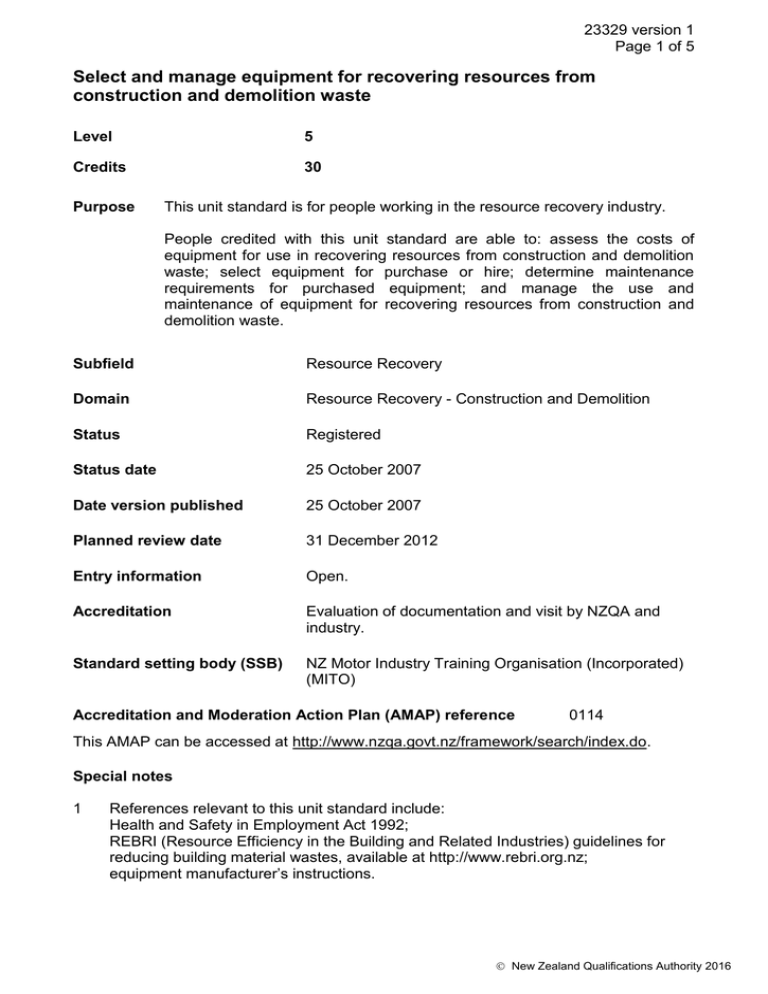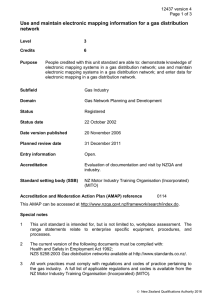Select and manage equipment for recovering resources from
advertisement

23329 version 1 Page 1 of 5 Select and manage equipment for recovering resources from construction and demolition waste Level 5 Credits 30 Purpose This unit standard is for people working in the resource recovery industry. People credited with this unit standard are able to: assess the costs of equipment for use in recovering resources from construction and demolition waste; select equipment for purchase or hire; determine maintenance requirements for purchased equipment; and manage the use and maintenance of equipment for recovering resources from construction and demolition waste. Subfield Resource Recovery Domain Resource Recovery - Construction and Demolition Status Registered Status date 25 October 2007 Date version published 25 October 2007 Planned review date 31 December 2012 Entry information Open. Accreditation Evaluation of documentation and visit by NZQA and industry. Standard setting body (SSB) NZ Motor Industry Training Organisation (Incorporated) (MITO) Accreditation and Moderation Action Plan (AMAP) reference 0114 This AMAP can be accessed at http://www.nzqa.govt.nz/framework/search/index.do. Special notes 1 References relevant to this unit standard include: Health and Safety in Employment Act 1992; REBRI (Resource Efficiency in the Building and Related Industries) guidelines for reducing building material wastes, available at http://www.rebri.org.nz; equipment manufacturer’s instructions. New Zealand Qualifications Authority 2016 23329 version 1 Page 2 of 5 2 This unit standard requires assessment against at least three types of small equipment such as scales, personal protective equipment, hand tools, and power tools; and at least one item of mobile and/or heavy equipment such as front end loader, crane, sorting belt, crusher, or wire stripper. Office equipment is excluded. 3 Definition Company procedures means the documented methods for performing work activities and include health and safety, environmental, and quality management. Elements and performance criteria Element 1 Assess the costs of equipment for use in recovering resources from construction and demolition waste. Performance criteria 1.1 Assessment identifies nature of intended work and working conditions in accordance with company procedures. Range 1.2 Equipment is assessed in relation to operating costs in accordance with company procedures. Range 1.3 costs – purchase or hire, registration, road user charges (where relevant), operating costs; operating costs include but are not limited to – fuel consumption, tyres, repairs and maintenance, daily operation, hourly operation. Assessment identifies the purchase costs and hire costs of the equipment in accordance with company procedures. Range 1.6 materials – type, location, anticipated volume. Assessment of mobile equipment costs determines short term and long term costs in accordance with company requirements. Range 1.5 operating costs may include but are not limited to – length of time equipment will be used, workload, capacity, load requirements, logistics, age, mechanical condition of equipment. Assessment analyses capacity of equipment to handle anticipated materials in accordance with end-product specifications. Range 1.4 nature of work– sorting, loading, transporting; conditions – safety, indoors, outside. purchase costs include but are not limited to – depreciation, insurance, finance. Assessment determines storage cost of equipment ownership. New Zealand Qualifications Authority 2016 23329 version 1 Page 3 of 5 Element 2 Select equipment for purchase or hire. Performance criteria 2.1 The selection process compares costs of equipment in accordance with company procedures. Range 2.2 The selection process compares equipment supplier details in accordance with company requirements. Range 2.3 may include but is not limited to – price, terms of sale, trade-in. may include but is not limited to – level of service, warranty, after sales service, track record. Purchase or hire agreement and delivery details are determined for selected equipment in accordance with company requirements. Range conditions agreed to between parties; may include but is not limited to – terms of hire, level of service, warranty. Element 3 Determine maintenance requirements for purchased equipment. Performance criteria 3.1 Equipment is inspected for the purpose of drawing up maintenance programmes in accordance with company procedures. 3.2 Servicing records, and equipment wear and tear reports, are checked for servicing intervals and maintenance requirements in accordance with company procedures. 3.3 Maintenance plans, including estimated costs, are drawn up in accordance with company procedures. Range includes but is not limited to – availability of parts, automated lubrication, access to and ease of service, frequency of service periods, warranty conditions. New Zealand Qualifications Authority 2016 23329 version 1 Page 4 of 5 Element 4 Manage the use and maintenance of equipment for recovering resources from construction and demolition waste. Performance criteria 4.1 Management ensures that personal protective equipment is used for operating and maintaining equipment in accordance with manufacturer’s instructions. 4.2 Management ensures that operators are competent to operate the equipment in accordance with the Health and Safety in Employment Act. Range competence includes but is not limited to – induction, training, licence. 4.3 Management ensures that equipment use and maintenance are recorded and damage is reported in accordance with company procedures. 4.4 Management ensures that routine servicing of equipment is carried out in accordance with manufacturer’s instructions and/or company procedures. Range 4.5 servicing may include but is not limited to – cleaning, lubrication, fuel, maintaining coolant levels, regular replacement of parts such as air filters. Liaison with specialist service people is established in accordance with company procedures. Range specialist services may include but are not limited to – calibration, electrical repair, hydraulic hoses, tyres, engine repair, cooling system; requirements for – instructions, supply, timing, location, and records; may include service contracts. Please note Providers must be accredited by NZQA, or an inter-institutional body with delegated authority for quality assurance, before they can report credits from assessment against unit standards or deliver courses of study leading to that assessment. Industry Training Organisations must be accredited by NZQA before they can register credits from assessment against unit standards. Accredited providers and Industry Training Organisations assessing against unit standards must engage with the moderation system that applies to those standards. New Zealand Qualifications Authority 2016 23329 version 1 Page 5 of 5 Accreditation requirements and an outline of the moderation system that applies to this standard are outlined in the Accreditation and Moderation Action Plan (AMAP). The AMAP also includes useful information about special requirements for organisations wishing to develop education and training programmes, such as minimum qualifications for tutors and assessors, and special resource requirements. Comments on this unit standard Please contact the NZ Motor Industry Training Organisation (MITO) info@mito.org.nz if you wish to suggest changes to the content of this unit standard. New Zealand Qualifications Authority 2016







